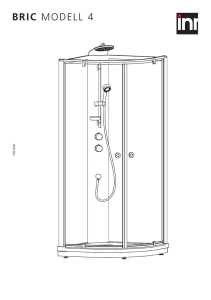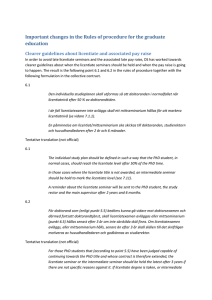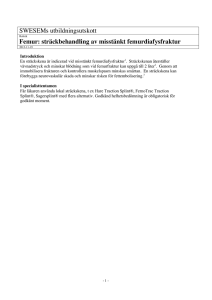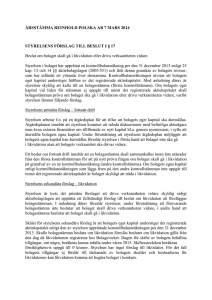SWESEMs utbildningsutskott Bäckenstabilisering med gördel
advertisement
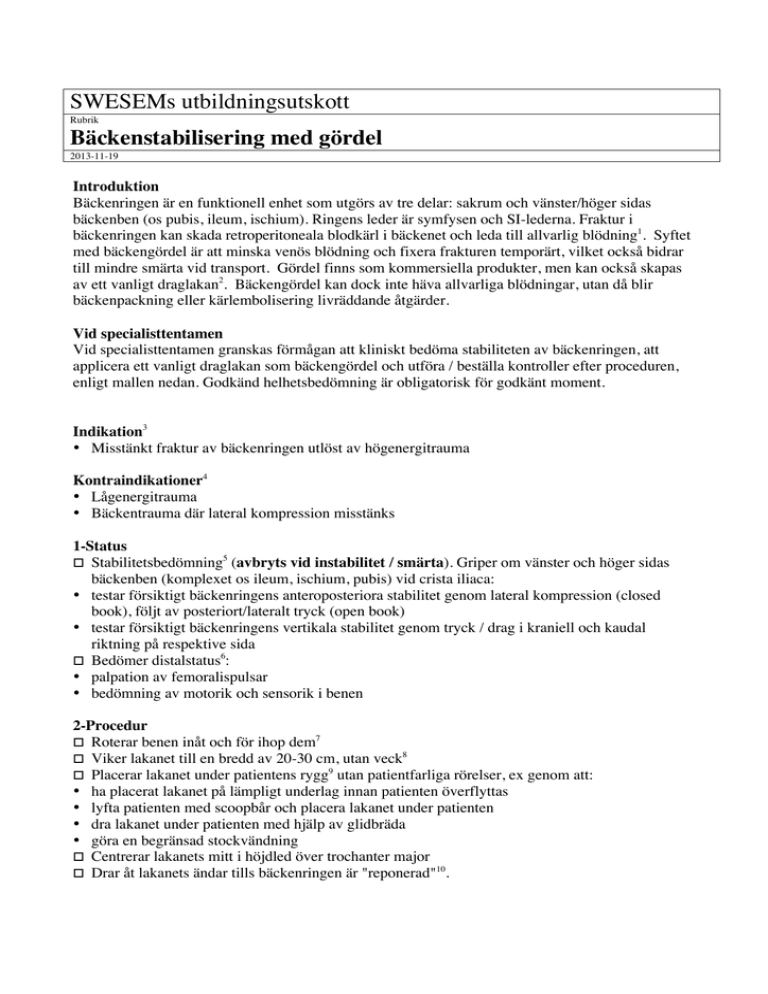
SWESEMs utbildningsutskott Rubrik Bäckenstabilisering med gördel 2013-11-19 Introduktion Bäckenringen är en funktionell enhet som utgörs av tre delar: sakrum och vänster/höger sidas bäckenben (os pubis, ileum, ischium). Ringens leder är symfysen och SI-lederna. Fraktur i bäckenringen kan skada retroperitoneala blodkärl i bäckenet och leda till allvarlig blödning1. Syftet med bäckengördel är att minska venös blödning och fixera frakturen temporärt, vilket också bidrar till mindre smärta vid transport. Gördel finns som kommersiella produkter, men kan också skapas av ett vanligt draglakan2. Bäckengördel kan dock inte häva allvarliga blödningar, utan då blir bäckenpackning eller kärlembolisering livräddande åtgärder. Vid specialisttentamen Vid specialisttentamen granskas förmågan att kliniskt bedöma stabiliteten av bäckenringen, att applicera ett vanligt draglakan som bäckengördel och utföra / beställa kontroller efter proceduren, enligt mallen nedan. Godkänd helhetsbedömning är obligatorisk för godkänt moment. Indikation3 • Misstänkt fraktur av bäckenringen utlöst av högenergitrauma Kontraindikationer4 • Lågenergitrauma • Bäckentrauma där lateral kompression misstänks 1-Status 5 Stabilitetsbedömning (avbryts vid instabilitet / smärta). Griper om vänster och höger sidas bäckenben (komplexet os ileum, ischium, pubis) vid crista iliaca: • testar försiktigt bäckenringens anteroposteriora stabilitet genom lateral kompression (closed book), följt av posteriort/lateralt tryck (open book) • testar försiktigt bäckenringens vertikala stabilitet genom tryck / drag i kraniell och kaudal riktning på respektive sida 6 Bedömer distalstatus : • palpation av femoralispulsar • bedömning av motorik och sensorik i benen 2-Procedur 7 Roterar benen inåt och för ihop dem 8 Viker lakanet till en bredd av 20-30 cm, utan veck 9 Placerar lakanet under patientens rygg utan patientfarliga rörelser, ex genom att: • ha placerat lakanet på lämpligt underlag innan patienten överflyttas • lyfta patienten med scoopbår och placera lakanet under patienten • dra lakanet under patienten med hjälp av glidbräda • göra en begränsad stockvändning Centrerar lakanets mitt i höjdled över trochanter major 10 Drar åt lakanets ändar tills bäckenringen är "reponerad" . Fixerar lakanet. Antingen läggs lakanets ändar omlott på framsidan och fixeras med fyra stora peanger, eller knyts lakanets ändar i varandra11. 3-Kontroller 12 Upprepar distalstatus 13 Beställer/bedömer röntgen av bäckenet Helhetsbedömning Genomför färdigheten på ett patientsäkert sätt och ändamålsenligt sätt Uppvisar förtrogenhet med handgreppen ANTECKNINGAR 1-Bäckenfraktur "Fractures of the pelvic ring are potentially life-threatening complications of high-energy trauma, such as that caused by motor vehicle collisions (Fig. 1A).1 The primary mode of death from these fractures is hemorrhage from the pelvic retroperitoneal vasculature. Sustained hemorrhage can occur because fractures that open the pelvic ring increase the pelvic retroperitoneal volume, creating a space that can accommodate a large amount of blood. Typically, fractures of the pelvic ring also cause mechanical instability. This instability contributes to further hemorrhage when thrombi are disrupted during manipulation of the patient." (Rajab 2013) 2-Bäckengördel "To reduce hemorrhage from pelvic-ring fractures, the American College of Surgeons Committee on Trauma recommends early temporary pelvic stabilization.2 This stabilization can be achieved with the use of circumferential pelvic sheeting (Fig. 1B and 2).3 The rationale for this intervention is to achieve tamponade of the pelvic retroperitoneum by decreasing its volume and to support thrombus formation by mechanically stabilizing the fracture.4" (Rajab 2013) “Bäckenskadorna kan grovt indelas i stabila och instabila. Vid de stabila skadorna är en del av bäckenet avslaget, såsom kristakanten eller tvärfraktur på sakrum. Isolerade ramusfrakturer räknas också hit även om man vid dessa skador bör misstänka skador även på de bakre delarna av bäckenet. Bäckenringen förblir vid dessa skador stabil. Vid de instabila är bäckenringen (skelett eller ligamentapparat) avslagen på minst två ställen och bäckenhalvorna blir då förskjutbara mot varandra i horisontal eller vertikal riktning beroende på skada. De instabila (framför allt med vertikal instabilitet) är ofta kombinerade med kärlskador och kan ge livshotande blödningar. Transport av en patient med instabil bäckenfraktur utan tillräcklig immobilisering kan dels utlösa/förvärra blödning och ge skador på andra organ, dels förorsaka avsevärd smärta som i kombination med frisättande av produkter från skadad vävnad kan ge systemkomplikationer till trauma, som ARDS.” (Lennquist 2007) "The most readily available means to quickly stabilize the pelvis in the ED may be realized with a simple sheet and towel clamps. Wrapping the pelvis tightly with a sheet and securing this with towel clamps has been shown to be effective in reducing an open-book pelvic injury (Fig. 5512),79,80 thereby reducing the potential volume in the pelvis for blood loss." (Choi 2013) "Gördeln kan utgöras av lakan, bälte eller slynga av tygstycke, som räcker runt patientens bäcken. Med slyngan runt bäckenet antar man att de venösa blödningarna minskar och frakturen fixeras temporärt, vilket även bidrar till att blödning minskar [4]. Vid samtidig arteriell blödning kan hypotoni uppstå, vilket kräver akuta interventioner på sjukhus." (Sandersjöö 2013) "Stabilization of the pelvis consists primarily of compressing the bony ring. This can be accomplished by using a sheet or commercially available pelvic binder." (Klimke 2013) "Currently, there is insufficient evidence to support one device over another. The two devices with the strongest evidence base are the SAM pelvic sling and T-POD devices." (Scott 2013) ”En vakummadrass, som nu finns i de flesta ambulanser och är en bra fixation vid ryggskador och även stabila bäckenfrakturer, är otillräcklig fixation vid instabil bäckenfraktur eftersom större kraft krävs för hålla samman bäckenhalvorna. Den bör därför kompletteras med en transportgördel som dras åt runt bäckenet och pressar ihop bäckenringen, vilket har effekt både genom att motverka eller stoppa blödning och genom att hindra rörelse och därmed smärta under förflyttning och transport. I avsaknad av sådan gördel kan man ta ett draglakan (motsvarande) som knyts runt bäckenet.” (Lennquist 2007) 3-Indikation "Circumferential pelvic sheeting is indicated for patients with high-energy fractures that open the pelvic ring and cause hemodynamic instability. Such fractures frequently result from anteroposterior compression (Fig. 3). This force vector opens the pelvic ring by distracting the sacroiliac joints and causes hemodynamic instability by tearing retroperitoneal vascular structures." (Rajab 2013) "For any patient with significant pelvic pain or tenderness or evidence of pelvic instability after trauma, apply a pelvic circumferential compression device, especially if the patient is hypotensive." (Klimke 2013) "Om patienten har smärtor i bäcken eller ljumskar immobiliseras bäckenet [3]. Det är viktigt att förhindra att okontrollerad blödning uppkommer. Det anses vara en fördel att stabilisera en bäckenskada så tidigt som möjligt medan koagulationsförmågan är intakt." (Sandersjöö 2013) 4-Kontraindikationer "Circumferential pelvic sheeting is contraindicated when other life-threatening injuries take priority. Such injuries include those affecting the patient’s airway, breathing, or circulation. It is also important to differentiate high-energy mechanisms of injury from low-energy mechanisms of injury. Patients with osteoporosis who fall at ground level can easily fracture their pelvis, but these fractures rarely disrupt the pelvic vasculature. Circumferential pelvic sheeting is contraindicated in patients with low-energy pelvic fractures because it can cause further damage to osteoporotic bones. Unlike anteroposterior fractures, lateral compression fractures close the pelvic ring by compressing the innominate bones. In patients with such fractures, the compressed retroperitoneum causes tamponade of the pelvic vasculature. Consequently, lateral compression fractures rarely cause hemodynamic instability. Circumferential pelvic sheeting is contraindicated for fractures that are known to be caused by lateral compression because the concentric force from the circumferential sheet can worsen the deformity." (Rajab 2013) "The patient’s history should clarify the mechanism of injury, including the direction of the force vector. Possible force vectors affecting the pelvis are anteroposterior compression, lateral compression, and vertical shear.5 Pelvic sheeting is most useful in patients with fractures resulting from anteroposterior compression. It is contraindicated in patients with lateral compression fractures." (Rajab 2013) "Understanding the mechanism of injury is an important means of determining a patient’s risk of having a pelvic fracture and, if present, the pattern and severity of the fracture. Low-energy injuries (e.g., fall on level ground) typically cause stable injuries to the pelvis; patients who have sustained high-energy injuries (e.g., MVCs, falls from heights) are at risk for unstable fracture patterns of the pelvis as well as associated injuries to other organ systems." (Choi 2013) "Patients who have sustained AP open-book injuries are likely to derive the most benefit from tight wrapping of the pelvis. This maneuver may not be desirable when lateral compression forces have already internally rotated the hemipelvis because indiscriminately forceful wrapping may, in fact, worsen the degree of displacement. Here, some judgment is required to discern whether one is wrapping the pelvis to reduce the volume of an externally rotated pelvis versus splinting a pelvis to minimize pelvic movement that may occur, especially when the patient is transferred." (Choi 2013) 5-Stabilitetsbedömning "The physical examination serves to identify the area or areas of pelvic mechanical instability. To examine the pelvis, firmly grasp the left innominate bone with your right hand and the right innominate bone with your left hand. First, examine the extent of anteroposterior instability by compressing and distracting the innominate bones. Next, examine the extent of vertical instability by pushing the innominate bones cephalad and then pulling caudad. If the pelvis is unstable, one or both of these manipulations will cause pain or movement of the innominate bones. It is important to minimize manipulation of the injured pelvis. Therefore, the examination should stop if mechanical instability is detected. At this point, if there are no contraindications, the pelvis should be stabilized with a circumferential pelvic sheet. When appropriate, the clinical examination can be replaced with or complemented by pelvic radiography." (Rajab 2013) "aggressively moving patients or palpating the injured pelvis (e.g., pelvic rock) can precipitate further vascular injury or clot disruption and lead to life-threatening hemorrhage." (Klimke 2013) "Man bör inte stabilitetspröva bäckenet prehospitalt, eftersom det kliniska värdet av denna undersökning är tveksamt; undersökningen i sig kan också medföra okontrollerad blödning på skadeplatsen. Försiktig palpation av bäckenet är acceptabel men ska utföras endast en gång." (Sandersjöö 2013) "Prehospital diagnosis of a pelvic fracture can be extremely difficult.3 There is no obvious external bleeding and deformities can be difficult to detect. Grant 1990 found that ‘springing the pelvis’ had a poor sensitivity (59%) and specificity (71%).5 There is also concern that compressing the pelvis can cause further haemorrhage and as a result this technique is no longer recommended.3 5 Significant pelvic trauma can be excluded from a small group of patients preventing the unnecessary use of pelvic binders. These patients must be haemodynamically stable with a normal Glasgow Coma Scale." (Scott 2013) "even the most experienced prehospital provider may find it difficult to identify pelvic injuries in the field (the exception being an open-book fracture)." (Klimke 2013) ”Synlig felställning, tecken på förskjutning vid försiktig kompression över bäckenhalvorna. Vid misstanke ska skadan betraktas som instabil. En sådan skada får aldrig skickas vidare vare sig till eller inom sjukhuset utan så effektiv immobilisering som möjligt.” (Lennquist 2007) "Careful palpation of the pelvic ring to seek the presence of point tenderness is imperative; palpation starts at the symphysis anteriorly and proceeds to both pubic rami, the iliac spines and crests, and finally to the sacrum and SI joints posteriorly. The presence of tenderness in any of these locations is an important indicator of pelvic ring injury in alert patients without distracting injury." (Choi 2013) "Manipulation of the pelvis during physical examination should be gentle and kept to a minimum. “Springboarding” of the pelvis (i.e., vigorous downward pressure on the anterior superior iliac spines) to assess the rotational stability of the pelvic ring should be strictly avoided, as this maneuver has the potential to disrupt any tenuous blood clotting that may have occurred around a fracture site and may therefore worsen hemorrhage." (Choi 2013) 6-Distalstatus "The physical examination concludes with an evaluation of the neurovascular status of the legs, which involves palpating the femoral arteries and testing the motor and sensory function of the legs and feet. The results of this evaluation serve as the baseline for the detection of neurovascular compromise." (Rajab 2013) "The presence and quality of pulses in the lower limb should be assessed, as should sensation, strength, and deep tendon reflexes." (Choi 2013) 7-Benen inåtroteras och förs ihop "I en akut situation inleds detta med att inåtrotera och föra ihop benen, vilket minskar volymen i lilla bäckenet." (Sandersjöö 2013) "A technique of taping the lower extremities in internal rotation has also been described as a means of achieving a closed pelvic reduction in the presence of symphyseal diastasis." (Choi 2013) 8-Lakanet viks "To stabilize the pelvis, fold the sheet longitudinally to a width of 20 to 30 cm. Wrinkles should be avoided to minimize pressure on the skin." (Rajab 2013) "Because prolonged pressure from the sheet may compromise the integrity of the skin,4 wrinkles must be minimized, and the sheet should be applied over a broad area to distribute the pressure on the skin." (Rajab 2013) "There is evidence that with a pelvic binder in place, tissue under the binder is at risk of pressure necrosis." (Scott 2013) 9-Lakanet placeras under ryggen i höjd med trochanter major "Next, the folded sheet is positioned beneath the patient. Protection of the spine is maintained with the use of “logrolling.” The sheet should be centered at the level of the greater trochanters (Fig. 2). If the sheet is placed too far above or below the greater trochanters, the asymmetrical force applied across the pelvis can worsen the deformity. Since many patients with fractures of the pelvic ring have associated abdominal injuries, the sheet should be positioned low enough to allow for serial assessments of the abdomen and for further interventions, such as laparotomy." (Rajab 2013) "The greater trochanter is the surface landmark used for positioning the sheet. This bony prominence is the only palpable lateral projection of the proximal femur." (Rajab 2013) "To apply a sheet, place it over a long spine board and then gently logroll the patient (but no more than 15 degrees) into position on the board.78 Alternatively, lift the patient with a scoop stretcher and then slide the sheet beneath the patient." (Klimke 2013) "There is evidence that logrolling patients with significant pelvic fractures can cause clot disruption and further haemodynamic compromise.3 Patient handling must therefore be approached with care in these patients. Logrolling only has a place in turning a patient onto their back to allow access to their airway. There is no place for routine logrolling in blunt trauma victims. Patients should be moved with the aid of a scoop stretcher. No patient should be logrolled onto or off a spinal board with a pelvic injury." (Scott 2013) 10-Kompression "Once the sheet is in place, the ends should be crossed anteriorly and pulled tightly until the pelvic bones are reduced. The goal is to deliver the primary concentric force of the circumferential sheet at the level of the greater trochanters." (Rajab 2013) 11-Clamps "The ends of the sheet should then be secured with Kelly clamps. The tips of the clamps should be pointed laterally to avoid pinching the skin. If clamps are not available, the ends of the sheet may be tied in a knot." (Rajab 2013) 12-Distal status "After the sheet has been secured, the neurovascular status of the legs should be reexamined to determine whether any neurovascular compromise has been introduced." (Rajab 2013) 13-Röntgen "Pelvic radiographs should be obtained as soon as possible to confirm adequate reduction of the fracture." (Rajab 2013) "The most serious complication of circumferential pelvic sheeting is overcorrection of the fracture (Fig. 4), which can result in further injury to pelvic organs and neurovascular structures.3 Therefore, it is important to reexamine the patient after the sheet has been secured and to obtain a follow-up radiograph as soon as possible. If the fracture has been overcorrected, the sheet should be loosened and another set of radiographs obtained." (Rajab 2013) "The use of an x-ray machine can be helpful in confirming that adequate fracture reduction has been achieved." (Rajab 2013) "En frontal bäckenröntgen ger tillräcklig första information, dvs om patienten har en fraktur eller inte." (Sandersjöö 2013) Referenser Choi SB, Cwinn AA. Chapter 55—Pelvic Trauma. In: Marx JA, editor. Rosen’s Emergency Medicine: Concepts and Clinical Practice, 8th edition. Philadelphia: Elsevier; 2013 Klimke A, Furin M. Chapter 46—Prehospital Immobilization. I: Roberts J, Hedges J, editors. Roberts: Clinical Procedures in Emergency Medicine, 6th ed. Philadelphia, WB Saunders, 2013 Lennquist S. Kapitel 5--Primärt omhändertagande. I: Lennquist S, redaktör. Traumatologi, första upplagan. Stockholm, Liber, 2007 Rajab TK, Weaver MJ, Havens JM. Technique for Temporary Pelvic Stabilization after Trauma. N Engl J Med 2013; 369:e22 Sandersjöö G, Tötterman A, Jansson KÅ. Initial handläggning avgörande vid svår bäckenskada. Läkartidningen 2013;110:350-3 Scott I, Porter K, Laird C, Greaves I, Bloch M. The prehospital management of pelvic fractures: initial consensus statement. Emerg Med J 2013;30:1070-2

